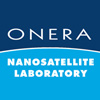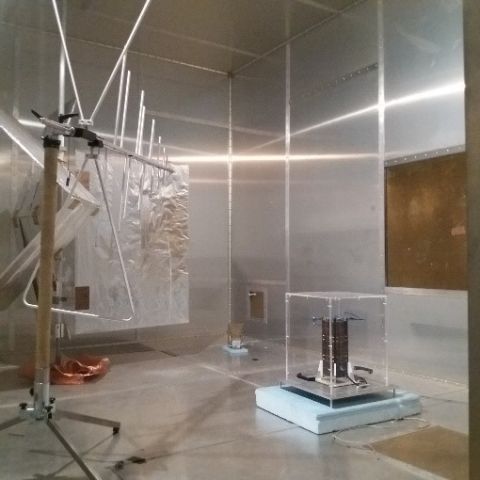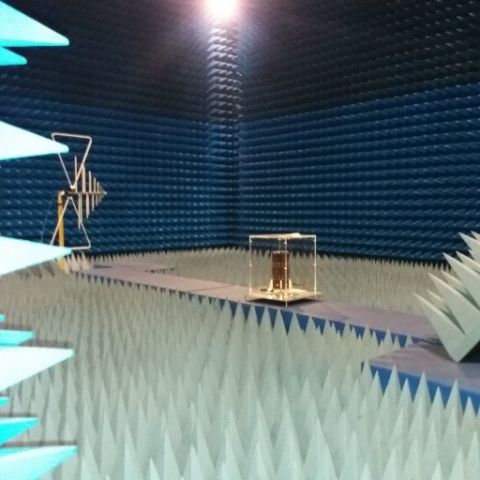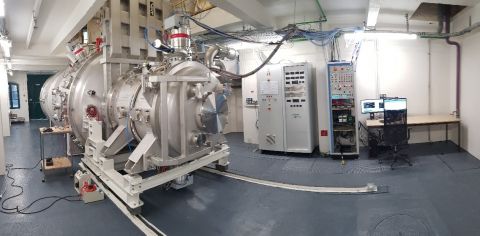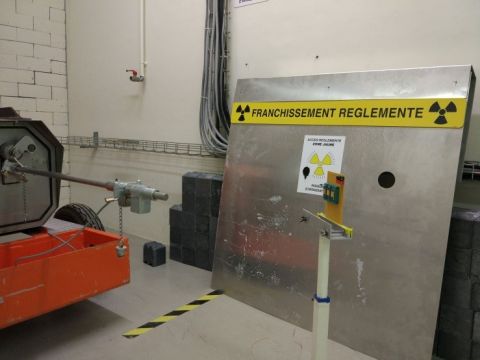EMI / EMC test
Several benches are available in Toulouse to test electromagnetic susceptibility or interferences and to measure antenna radiation patterns. A reverberation room (4.9 m x 3.7m x 3.2m) can be used down to 250 MHz. An anechoic room (10 m x 7 m x 4 m) is designed for a minimum frequency of 150 MHz and includes a spinning platform. Finally, a smaller reverberation chamber (2.4 m x 1.2 m x 2.2 m) completes the experimental setup.
| The reverberation (left) and the anechoic (right) rooms with the 3U Cubesat test platform | ||
Electric propulsion test benches
Different test benches are available at ONERA. The ERIS facility is designed to perform a comprehensive test of an electrical propulsion system. Its large volume (5 m x 2.3 m) can host a whole nanosat and its vacuum capacity (3e-8 mbar) allows it to evaluate the ignition of the propulsion system. Other chambers have been acquired to support the design and to test small thrusters (down to micro-newton) as well as a wide range of power (> 1 kW).
| The ERIS test bench at ONERA’s facility in Palaiseau, France |
Radiation effects in electronics components and materials
Several radiation facilities and test benches, as well as software, have been developed at ONERA, Toulouse. This expertise allows us and our partners to assess, anticipate and qualify the reliability of embedded electronics and materials in harsh environment conditions including radiation, extreme temperatures, and high vacuum.
Electronic systems require to be tested under radiation to anticipate Single Event Effects (SEE) and the impact of the Total-Ionizing-Dose (TiD), based on standards [1] and [2]. For instance, TiD in CMOS are tested in our gamma ray facility (MEGA) with a flux of 36–360 rad(Si)/h. The emergence of deep sub-100 nm technologies requires adapting SEE test process, particularly for single event latch-up (SEL) issued for nano and small satellites. Thus, microcontroller, FPGA, SoC can be evaluated at ONERA in a dedicated vacuum chamber (CIRIL) allowing the mounting of a small radiation source, for instance Californium emitting alphas [3].
In addition to experimental activities, ONERA developed radiation-engineering software dedicated to the estimation of soft error rates of embedded avionics (SEE-U) in orbits. See [4] for further details.
| MEGA facility for Total Ionizing Dose tests and analysis at ONERA in Toulouse, France |
For materials, the complexity and wide diversity of mechanisms at play in the diverse organic or inorganic materials forbid generic approach. Thus, testing of radiation damage (charged particles and/or UV, combined or not) in varied materials requires specific test conditions for each. Susceptible materials include polymers, thermal control paints or external surface of structural materials used for thermal control applications, Second Surface Mirror (SSM) or glasses. ONERA has developed the ALEX laboratory to provide a comprehensive test facility for material. It includes two Van De Graff accelerators (electrons and protons with energies up to 2 MeV) and three target chambers: SEMIRAMIS (surface material such as space painting and coverglass), MIRAGE (optoelectronics and solar cells) and GEODUR (for bulk charging in dielectrics). See [5] for further details.
Vacuum chambers
Several test platforms, of different sizes and including different features can be used in our facilities to test subsystems, Cubesat instruments or the whole platform. A TVAC setup (1 m high x 60 cm diameter) including thermally regulated plates can simulate heat load or sink. Another one with similar features is dedicated to infrared camera calibration.
ESD tests
The JONAS bench (3.4 long x 1.85 m diameter) is dedicated to test electrostatic discharge (ESD) by exposing the system to a plasma, electron beam and ultra-violet light.
[1] ESCC 25100 – Single event effects test method and guidelines
[2] ESCC 22900 – Total dose steady-state irradiation test method
[3] G. Hubert and L. Artola, "Experimental Evidence of Ground Albedo Neutron Impact on Soft Error Rate for Nanoscale Devices," in IEEE Transactions on Nuclear Science, vol. 66, no. 1, pp. 262-269, Jan. 2019, doi: 10.1109/TNS.2018.2877263.
[4] J.-C Matéo-Velez, L. Artola et al. “Assessment of Space Environment Effects on ESD Cubesat through new Spacesuite Code” 70th International Astronautical Congress (IAC), 2019
[5] S. Duzellier et al., "AXEL lab.: Representative Ground Simulation for Investigating Radiation effects in Materials and Electronics," 2017 17th European Conference on Radiation and Its Effects on Components and Systems (RADECS), 2017, pp. 1-7, doi: 10.1109/RADECS.2017.8696228
